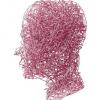According to https://www.selfhack.../blog/agmatine/
agmatine should be a miracle supplement for us all (proven to work on rats or mice of course).
anyone reporting any benefits in humans? i started taking it in the last 3 days and all I feel so far is being more tired (for sure), and maybe, maybe less social anxiety?
1) Agmatine Reduces Pain
Agmatine reduced hypersensitivity to pain and reduced the size of spinal cord injury in rats [R, R].
Furthermore, agmatine reduced neuropathic pain by preventing nitric oxide synthase activation and blocking NMDA receptors in rats [R].
In 2 studies (dose-escalation study and DB-PCT) of 61 participants with a herniated lumbar disk, agmatine supplementation for 10 days reduced pain and improved quality of life [R].
2) Agmatine May Help with Depression and AnxietyBy increasing NRF2, agmatine prevented depressive behavior in rats by protecting brain cells from high levels of the stress hormone cortisol [R].
Agmatine increased adenylate cyclase in the prefrontal cortex of rats. Decreased levels of adenylate cyclase are associated with depression [R, R].
Additionally, blocking the NMDA receptor prevents calcium overloading and reverses the decrease of monoamines (such as norepinephrine, epinephrine, and dopamine) in rats. Depression may be associated with a decrease of monoamines in the brain [R, R].
In a small pilot study of 3 depressed patients, agmatine supplementation caused a complete disappearance in depressive symptoms in all patients, likely through NMDA receptor-blocking and not through serotonin pathways [R].
Agmatine also reduced anxiety in rats during swimming tests and navigating mazes [R].
3) Agmatine May Promote Muscle GrowthAgmatine stimulated the production of luteinizing hormone (LH) in rats. Increased levels of LH increase testosterone levels. By increasing testosterone levels, agmatine contributed to an optimal hormonal environment for muscle growth and enhanced athletic performance [R].
Agmatine increased insulin sensitivity and uptake of glucose into the muscles of mice. Increased insulin sensitivity results in more effective shuttling of glucose and amino acids into muscles for growth and repair [R, R].
Agmatine also increased appetite in rats. An increased appetite can lead to increased caloric consumption, which is necessary for increasing muscle mass [R, R].
4) Agmatine May Protect the Brain from Damage Due to StrokeBy inhibiting iNOS and nNOS and increasing eNOS, agmatine protected against brain damage from stroke in rats. Increasing eNOS protects the brain by dilating the blood vessels to increase blood flow. This prevents damage during times of lack of oxygen from reduced blood flow to the brain (ischemic stroke). Additionally, agmatine decreased iNOS and nNOS, 2 enzymes that contribute to brain damage from stroke [R].
5) Agmatine May Improve Recording of Spatial MemoryAgmatine is increased during spatial learning tasks and is stored in high levels in the hippocampus (a region of the brain associated with memory). Its role as a neurotransmitter is associated with memory formation [R, R, R].
Agmatine improved spatial memory consolidation, or the initial recording and storing of a memory, but had no effect on the retrieval of memories in rats [R].
Agmatine increased brain-derived neurotrophic factor (BDNF) in the brains of rats, a molecule which stimulates the production of new brain cells (neurogenesis) [R].
Agmatine increased adenylate cyclase activity in the prefrontal cortex of rats, a molecule associated with memory formation [R].
6) Agmatine May Suppress Tumor GrowthAgmatine prevented the growth of connective tissue tumors in mice by the decreasing the level of molecules thought to be involved in tumor growth called polyamines [R, R, R].
Agmatine also prevented the growth of intestinal tumor cells in a lab study by decreasing polyamine production [R].
7) Agmatine May Improve Weight Loss and Prevent Weight GainAgmatine reduced weight gain in rats [R].
Agmatine increased fat burning, decreased fat composition, and increased muscle mass in rats [R].
8) Agmatine May Improve Insulin Sensitivity and Reduce Blood SugarAgmatine improved insulin sensitivity in insulin-resistant rats by reducing mTOR and glucose transporter 2 (GLUT2) production in rats [R, R, R].
Agmatine reduced blood sugar levels in rats by increasing β-endorphin production by the adrenal glands. β-endorphins cause the uptake of glucose from the blood into skeletal muscle tissue [R, R, R].
9) Agmatine May Help with Alzheimer’s DiseaseInsulin resistance can lead to the accumulation of plaque and neurofibrillary tangles in the brain, which are the hallmarks of Alzheimer’s disease. Agmatine prevented cognitive decline by rescuing insulin signaling and preventing the accumulation of plaques and neurofibrillary tangles in the brains of rats [R, R].
10) Agmatine May Protect Against Hardening of the ArteriesAgmatine reduced plaques (atherosclerotic lesions) that lead to hardening of the arteries by 40% and increased good (HDL) cholesterol levels in mice [R].
11) Agmatine May Increase Nerve RepairAgmatine increased nerve regeneration in rats with facial nerve injuries. This may be due to agmatine’s inhibition of nNOS, which can inhibit the growth and repair of neurons [R].
12) Agmatine Protects Against SeizuresGlutamate and the NMDA receptor have been implicated in the initiation and spread of seizure activity. Agmatine prevents seizures in mice and rats by blocking NMDA receptors [R, R].
13) Agmatine May Protect Against StressAgmatine significantly reduced high body temperature from prolonged heat stress and fever in mice caused by bacterial toxins called lipopolysaccharides (LPS). Agmatine also increased the survival rate of mice exposed to LPS [R].
14) Agmatine May Reduce InflammationAgmatine reduced inflammation by suppressing the expression of iNOS after inflammatory stimulation in rats [R].
In rats, agmatine prevented decreased blood pressure and kidney function associated with septic shock due to its anti-inflammatory effects [R].
15) Agmatine May Help with Alcohol and Morphine WithdrawalAgmatine prevented symptoms of alcohol withdrawal such as “wet dog shakes,” anxiety, and tremors in rats [R, R].























































